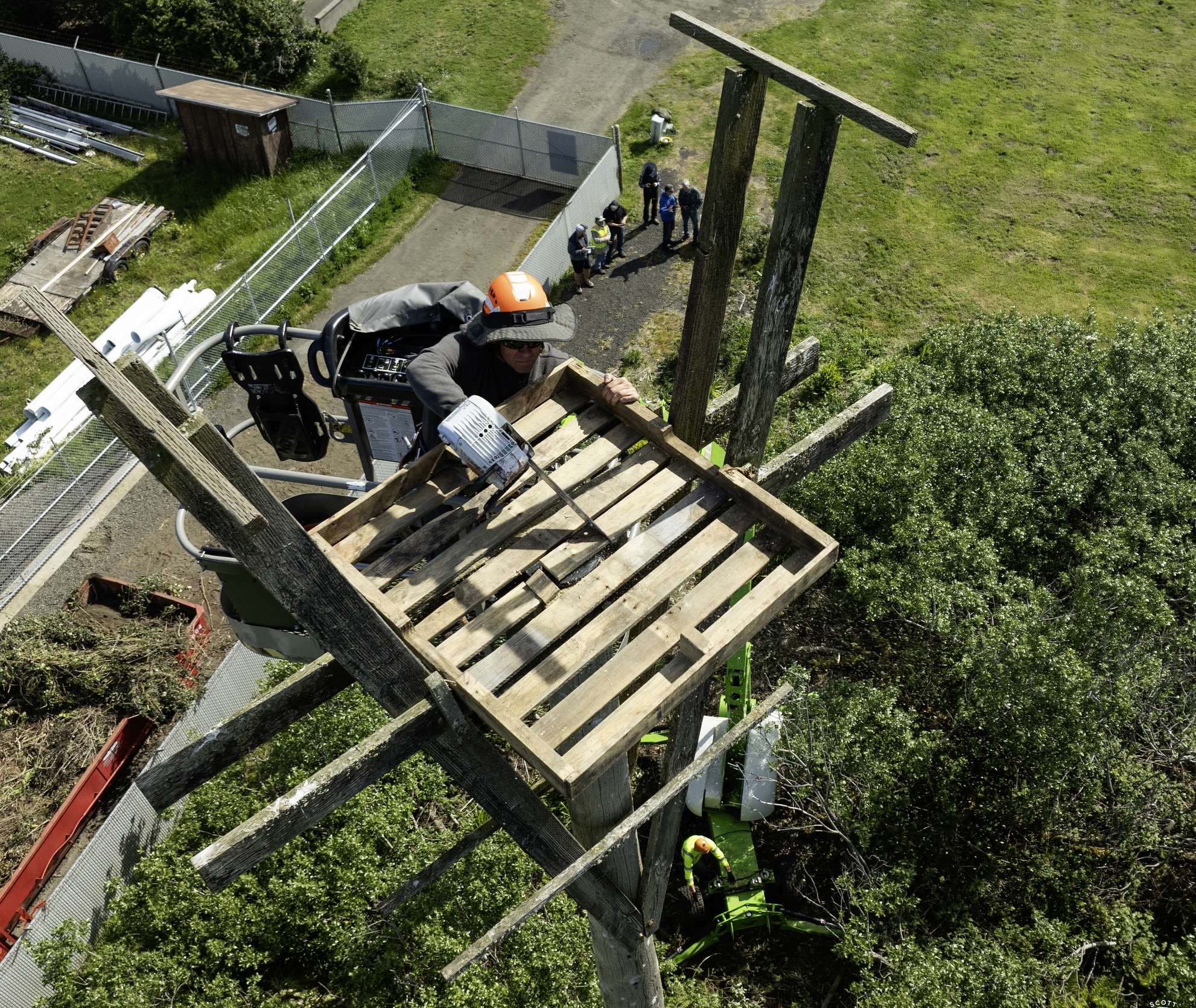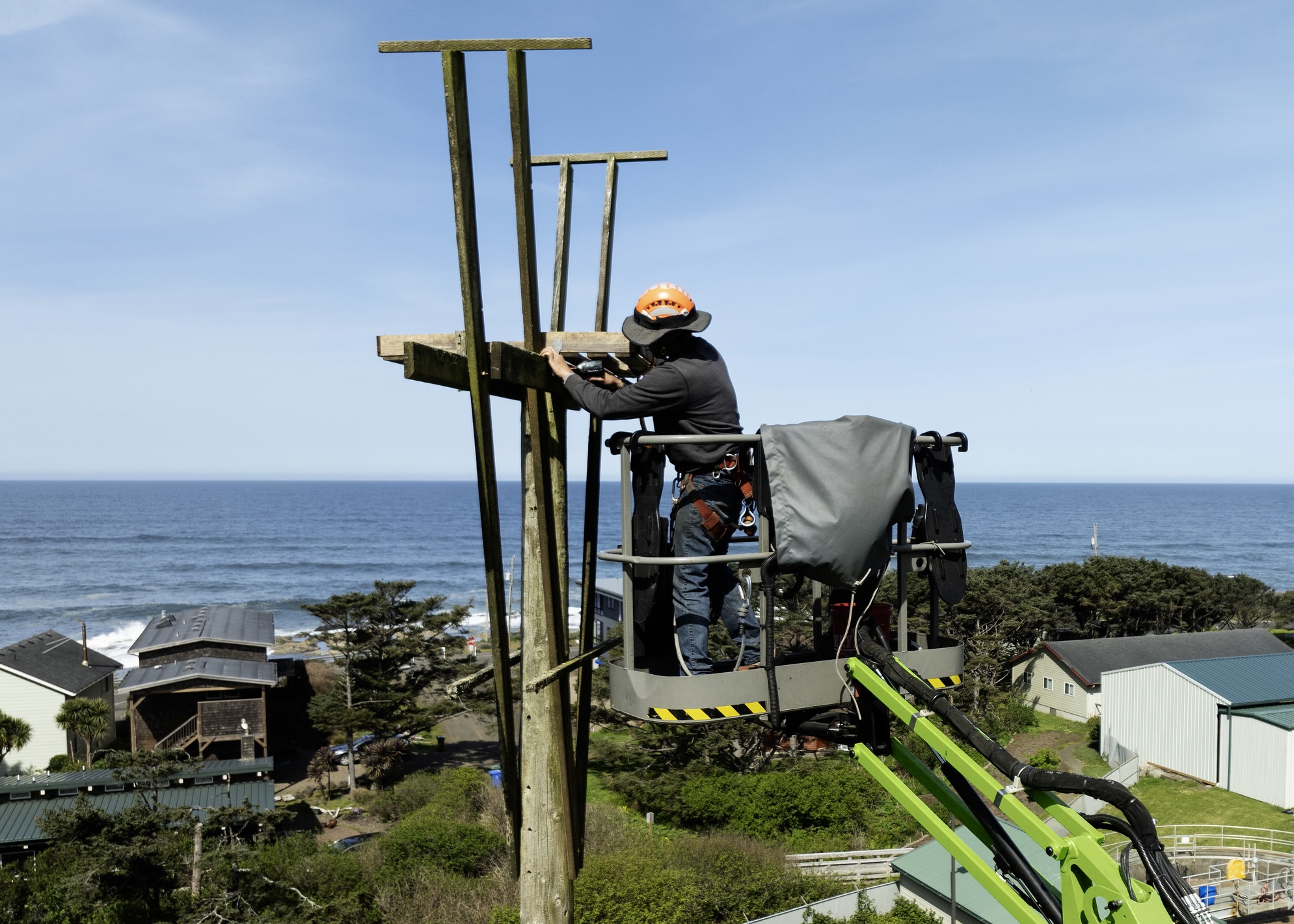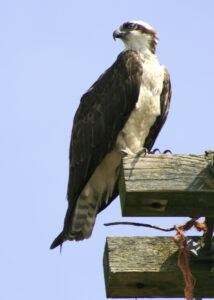
By GARRET JAROS/YachatsNews
YACHATS – With the foundation laid it’s now a game of wait-and-see whether efforts will work to entice ospreys to make a home in the heart of Yachats.
A flock of volunteers gathered on the northern fringe of the wetlands west of city hall Monday to attach an upturned pallet atop a 65-foot pole to serve as a nesting perch – with a bed of sticks added to sweeten the pot.

The weather-bleached pole was put in place in 2008 with the same purpose in mind. But the platform decayed and was blown away by the wind without ever having been occupied by nesting ospreys.
But that did not dissuade the plucky volunteers made up of members from Swallows In Flight to Yachats – better known by their acronym SWIFTY. They consulted with the Cascade Raptor Center in Eugene before collaborating with Parks & Commons’ commissioners – who rounded out the cadre of helpers Monday.
“They said this is a good place for the pole’s location,” Wally Orchard said of the raptor center’s advice. “It just needs a platform.”
Staff at the center were “very keen” on the idea because osprey need more nesting opportunities, said Orchard, who along with Jim Welch is a founding member of SWIFTY, which fledged three years ago to help “birds that need help and can be helped.” The group now builds and places birdhouses throughout Lincoln County.
Volunteers cut a swath through wood and brush in order to get a hydraulic lift to the base of the pole after efforts last week proved it was unsafe to climb. It was then up to tree climber Jason Stein to attach the platform. Stein, who lives in Eugene but owns property in the area, donated his time and labor.
“It’s getting old,” Stein said of the pole after finishing the job and loading the lift back on its trailer. “We’ll see if anybody moves in this year, and if they don’t, we’ll probably rebuild it next year.”
Stein’s goodwill in traveling twice from Eugene – first to attempt to climb the pole last week and to bring his lift this week – was rewarded with a passing-of-the-hat that garnered a gift certificate to the Drift Inn and a weekend stay at volunteer Ray Pedrick’s lighthouse-home on the northern flank of Cape Perpetua.
Osprey, which are also known as sea hawks, river hawks and fish hawks, return to their same nesting sites year after year. There are successful sites at Waldport’s Southworth Park and Eckman Lake.

All about ospreys

An adult osprey can weigh more than four pounds, though they average about three, and boast a wingspan just shy of six feet. They live an average of 15 to 20 years but the oldest documented in the United States was one in Virginia that lived past 25.
Osprey are found throughout the world and may log more than 160,000 migration miles during their lifespan. During 13 days in 2008, one osprey flew 2,700 miles from Martha’s Vineyard, Mass., to French Guiana, South America, according to the Cornell Lab of Ornithology.
They readily build nests on manmade structures such as telephone poles, channel markers, duck blinds and platforms designed especially for them. The platforms have become an important tool in re-establishing Ospreys in areas where they had disappeared.
Osprey are unique among North American raptors for their diet of live fish and ability to dive into water to catch them. Studies show they catch fish at least one out of every four dives with an average time of about 12 minutes spent hunting before making a catch.
They prey on fish swimming within three feet of the surface and rarely take fish over 16 inches long. Ospreys are unusual among hawks in possessing a reversible outer toe that allows them to grasp with two toes in front and two behind. Osprey and owls are the only raptors whose outer toe is reversible. This is particularly helpful in gripping slippery fish. Barbed pads on the soles of their feet also help.
Historically regarded as a symbol of vision and abundance – ospreys were decreed by the 2017 Oregon Legislature to be the state raptor.
- Garret Jaros is YachatsNews’ full-time reporter and can be reached at GJaros@YachatsNews.com




Strong work Jim and Wally!
The existing pole was put in place in about 2005 thanks largely to the vision and energy of Ray Meehan, who lived on Ocean View Drive. Central Lincoln PUD donated the pole. Ray and other volunteers built the platform and attached it to the pole. Someone donated the use of a helicopter that carried the pole over the wetlands and dropped it. The sharpened end sank deep into the ground. Sadly, Ray never got to see an osprey nesting on his pole, which never attracted a resident.